204. The great myths contain
all necessary information in memorable
form and the words in all our languages
support these myths, making the initial star
frame potentially eternal. The Chinese name
for ζ Corvi is one such example:
|
no glyph |
 |
 |
 |
 |
 |
 |
|
Ca1-1 |
Ca1-2 |
Ca1-3 |
Ca1-4 |
Ca1-5 |
Ca1-6 |
|
koia |
ki te hoea |
ki te henua |
te rima te hau tea |
haga i te mea ke |
ki te henua - tagata honui |
|
Sept 20 (*183) |
264 |
EQUINOX |
23 (366 - 100) |
24 |
25 (*188) |
(59 + 183 + 27) |
|
St John's
day |
*96 |
177 = 6 *
29½ |
*98 |
*99 |
*188 - *88 |
*101 (30
June) |
|
Al
Fargh al Thāni-25 (Rear Spout)
0h (*366)
CAPH
(Hand) = β Cassiopeiae,
SIRRAH
(Navel of the Horse) = α
Andromedae
(0.5), ε Phoenicis, γ³ Oct.
(0.8) |
Uttara Bhādrapadā-27
(2nd of the Blessed Feet) /
Wall-14 (Porcupine)
ο
Oct. (1.3),
ALGENIB PEGASI
= γ Pegasi
(1.8) |
χ
Pegasi (2.1), θ Andromedae (2.7) |
σ
Andromedae (3.0), ι Ceti (3.3),
ζ Tucanae (3.5), ρ Andromedae, π
Tucanae (3.7) |
no star listed (4) |
ANKAA = α Phoenicis,
κ Phoenicis (5.0)
ALPHARD (α Hydrae)
|
λ
Phoenicis (6.3), β Tucanae (6.4) |
|
March 21 (*366) |
22 (*1) |
23 (82) |
24 |
JULIAN EQUINOX |
26 |
27 |
|
Christmas
Eve |
*96 + *183 |
360 = 6 *
60 |
*98 + *183 |
362 |
180 + 183 |
*284 (30
Dec) |
|
ALCHITA (The Southern Tent) = α Corvi, MA WEI (Tail
of the Horse) = δ Centauri
(183.7), ρ Centauri (183.9) |
PÁLIDA = δ
Crucis (184.6),
MEGREZ = δ
Ursae Majoris (184.9) |
Hasta-13 (Hand) /
Chariot-28 (Worm)
GIENAH = γ Corvi (185.1),
ε Muscae (185.2), ζ Crucis
(185.4),
ZANIAH = η Virginis
(185.9) |
CHANG SHA (Long Sand-bank)
= ζ Corvi
(186.3) |
INTROMETIDA = ε Crucis
(187.4),
ACRUX = α Crucis
(187.5) |
γ
Com. Berenicis (188.0), σ
Centauri (188.1),
ALGORAB =
δ Corvi (188.5),
GACRUX = γ
Crucis (188.7)
|
γ
Muscae (189.0),
AVIS
SATYRA = η Corvi (189.3),
ASTERION =
β Canum Ven. (189.5),
KRAZ = β
Corvi, κ Draconis (189.7) |

... After the great flood had at
long last receded, Raven had
gorged himself on the delicacies
left by the receding water, so
for once, perhaps the first time
in his life, he wasn't hungry.
But his other appetites, his
curiosity and the unquenchable
itch to meddle and provoke
things, to play tricks on the
world and its creatures, these
remained unsatisfied.
Raven gazed up and down the
beach. It was pretty, but
lifeless. There was no one about
to upset, or play tricks upon.
Raven sighed. He crossed his
wings behind him and strutted up
and down the sand, his shiny
head cocked, his sharp eyes and
ears alert for any unusual sight
or sound. The mountains and the
sea, the sky now ablaze with the
sun by day and the moon and
stars he had placed there, it
was all pretty, but lifeless.
Finally Raven cried out to the
empty sky with a loud
exasperated cry. And before the
echoes of his cry faded from the
shore, he heard a muffled
squeak. He looked up and down
the beach for its source and saw
nothing. He strutted back and
and forth, once, twice, three
times and still saw nothing.
Then he spied a flash of white
in the sand. There, half buried
in the sand was a giant
clamshell. As his shadow fell
upon it, he heard another
muffled squeak. Peering down
into the opening between the
halves of the shell, he saw it
was full of tiny creatures,
cowering in fear at his shadow.
Raven was delighted. Here was a
break in the monotony of the
day. But how was he to get the
creatures to come out of their
shell and play with him? Nothing
would happen as long as they
stayed inside the giant
clamshell ... |
"... Other early titles
for the whole [of Corvus] were Al Ajmāl,
the Camel, and Al Hibā, the Tent;
this last generally qualified by
Yamaniyyah, the Southern, to
distinguish it from that [λ] in Auriga
..." (Allen)
The pictorial nature of
at least some of the rongorongo glyphs is another
support for these great myths, and the 6th
glyph counted from the Tail of the Sun Horse
at the Full Moon at the time of the initial St
John's day (24 June) - and also 3 days after
the Long Sand-bank at the Full Moon in
day 266 (= 366 - 100) at the time of
rongorongo - was designed to draw
attention:

Here there are 3 elements
bound together. At left (in the past) we
can imagine the ghostly figure of Mother
Earth (henua) no longer
illuminated by the Sun Horse because his
tail was 6 days in the past. Darkness
has fallen over the earth - as when in
the evening a dark cloth would be thrown
over a bird cage to make him silent.
...When
the man, Ulu, returned to his
wife from his visit to the temple at
Puueo, he said, 'I have heard the
voice of the noble Mo'o, and he
has told me that tonight, as soon as
darkness draws over the sea and the
fires of the volcano goddess, Pele,
light the clouds over the crater of
Mount
Kilauea, the black cloth will
cover my head. And when the breath has
gone from my body and my spirit has
departed to the realms of the dead, you
are to bury my head carefully near our
spring of running water. Plant my heart
and entrails near the door of the house.
My feet, legs, and arms, hide in the
same manner. Then lie down upon the
couch where the two of us have reposed
so often, listen carefully throughout
the night, and do not go forth before
the sun has reddened the morning sky.
If, in the silence of the night, you
should hear noises as of falling leaves
and flowers, and afterward as of heavy
fruit dropping to the ground, you will
know that my prayer has been granted:
the life of our little boy will be
saved.' And having said that, Ulu
fell on his face and died ...
And the right element (in
front) seems to illustrate
darkness ahead. This is mea ke
in my preliminary glyph type dictionary:
|
 |
|
mea ke |
|
Ke.
1. Other;
different; different being;
hare ké, a different house;
e-ké-ro-á... e-ké-ro-á...
there are some who... and others
who...; me'e ké,
something distinct, different:
te puaka ina oona kuhane;
me'e ké te tagata, he hakari
oona, he kuhane, an animal
has no soul; man is different,
he has a body, and a soul;
matu'a ké, the other
relatives. 2. Ké te kairua,
person who turns up for
meals at other people's homes.
3. Used in exclamations:
hahau ké! what a cool
breeze!; hana ké! how
hot! takeo ké! how cold!
Vanaga.
Other,
distinct, different, diverse,
otherwise; koona ke,
elsewhere; tagata ke,
some one else; mea ke,
contrary, distinct, otherwise;
hakake, feint, stratagem,
to feign; hagake, to act
contrary. T Pau.: ke,
different. Mgv.: ke,
another, other, else, different,
of partial comparative value.
Mq.: ke, é, to be
different, changed, no longer
the same. Ta.: e,
different, strange, other.
Churchill. |
|
E, adv. and ppr.
Haw., from, away, off, by,
through, means of; also,
adverbially, something other,
something strange, new; adj.
contrary, opposed, adverse,
other, foreign. Sam.: e,
ppr. by, of; ese,
other different, strange. Ta.,
e, ppr. by,
through, from; adv. away,
off; adj. different,
strange, distant; ee,
strange. N. Zeal., ke,
strange, different.
Malg., eze,
of, by.
Greek,
έκ, έξ, from out
of, from, by, of; έκει,
in that place, opp. to
ένθαδε,
in some other place than that of
the speaker, thither;
έκας,
afar off. Lat., e, ex,
out of, from. Liddell and Scott
(Gr.-Engl. Dict., s. v.) say:
'The root of έτ-ερος is
said to be the same as Sanskr.
ant-aras, Goth.
auth-ar, Germ. and-er,
Lat. alt-er, aut, French
aut-rui, our eith-er,
oth-er, itara =
alius, also in Sanskrit.'
Whatever the root of ant-aras,
auth-ar, alter, it
seems to me that
έκας
shows nearer kindred to the
Polynesian e, ke,
ee, ese, eze,
than to forms so developed as
ant-ar, ant-ara, &c.
(Fornander) |
The central (important)
figure has water on his belly (navel) and he
could correspond to Aquarius - whose
sweet water was keeping Earth and Sky
locked close together in primal embrace. In
ancient Babylonia he was the Great
One:
|
Honui.
1. Person
worthy of respect, person of
authority. 2. Livelihood,
heirloom, capital; ka
moe koe ki toou hônui, you
must marry to ensure your
livelihood (said to a little
girl); he hônui mo taaku
poki, this is the heirloom
for my son. Vanaga. Great (hoonui);
honui, chief T.;
tagata hoonui, personage;
hakahonui, to praise, to
commend. Churchill. |
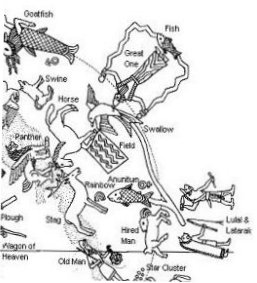
The fact that the stars of Aquarius was
at the other side of the sky compared to
dry Raven implies the halfyear
ruled by water ended where the Hydra
(Water Serpent) had his Tail:
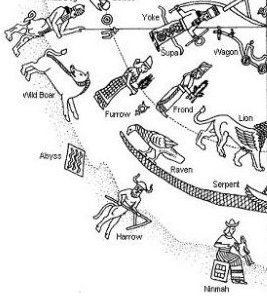
Therefore the water should
recycle by going
straight across from the Abyss -
i.e. as the Crow
flies - to the Great One who was standing on
a Fish as a sign of a position
far down below the surface of the earth,
the place towards which gravitation makes
sweet water flow.
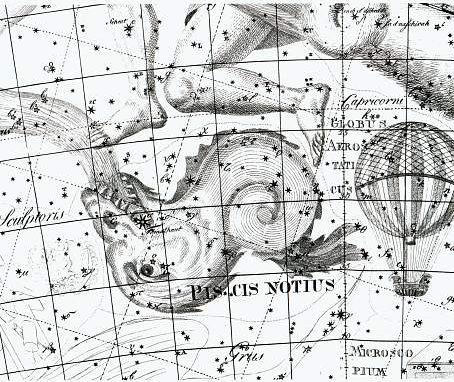
At
the time of Betelgeuze the position of Ca1-6
was where the Sun had been
in 30 June and the Full Moon in 30
December. A new half year should begin
with 31 December (365 = *285). At the time
of rongorongo, 88 precessional days
later, the Sun was in September 26 (269
= 181 + 88) and
the Full Moon in March 27 (*6 = *284 +
*88 - *366).
Day 269 can be understood to mean day
number 59 + 183 + 27 counted from
January 1. And 59 could correspond to
the number of days in January (31) and
February (28). 183 should be half *366,
and 27 ought to correspond to the right ascension
position of the First Point of Aries
(*27), which had been at 0h in Roman times.
I.e. the Julian calendar had inserted a
pair of months (the months of Julius and
Augustus) in the ancient
structure and precession had added
another 27 days.
But counted from 31 December instead of
from 1 January the day number should be
60 + 183 + 27 = 270. The
ancient Babylonians counted with 60:
...
Utnapishtim is spry enough to tell
[Gilgamesh] in great detail the story of
the Deluge. He tells how Enki-Ea has
warned him of Enlil's decision to wipe
out mankind, and instructed him to build
the Ark, without telling others of the
impending danger. 'Thus shalt thou say
to them: (I will ... go) down to the
apsu and dwell with Ea, my (lor)d.'
He describes with great care the
building and caulking of the ship, six
decks, one iku (acre) the floor
space, as much for each side, so that it
was a perfect cube [a sign of Saturn],
exactly as Ea had ordered him to do.
This measure '1-iku' is the name of the
Pegasus-square, and the name of the
temple of Marduk [the spring sun god] in
Babylon, as is known from the New Year's
Ritual at Babylon, where it is said:
'Iku-star, Esagil, image of heaven and
earth.'
... The Wing of the Pegasus horse was
where the Babylonians had their 1-iku
constellation, ruled by Anunitum (τ
Piscium) - and the Wing (Gienah)
of Raven was when in rongorongo times
the Sun reached the southern spring
equinox in September
...
... Esagila is '1-iku - the
Pegaus-square between the two Fishes
that ruled the hibernal solstice during
the Age of Gemini
...
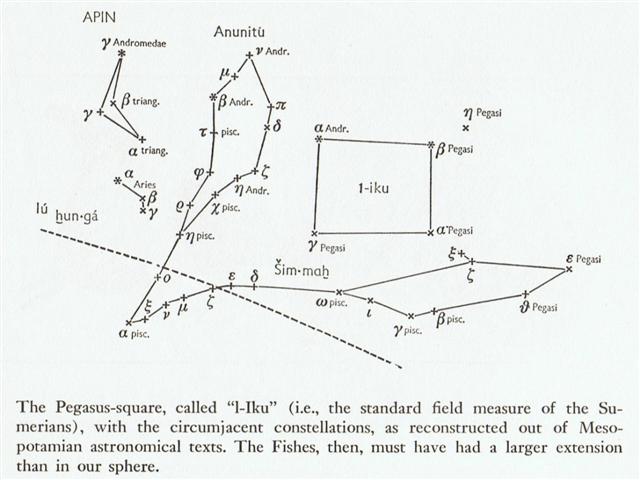
The hibernal solstice
during the Age of Gemini could have been
at a time when the Full Moon was at the
Long Sand-bank, because day 360 at the
time of Betelgeuze was when the Sun
reached 27 December and this was 6 days
after 21 December (355). Or counting
from 31 December in the previous year it
would have been day 360 + 1 and a week
after day 354.

|
Hagahuru.
Ten (agahuru,
hagauru). P Mq.:
onohuú, okohuú, id.
Ta.: ahuru. id.
Churchill.
The Maori
recognized two main divisions of
the year: winter or takurua,
a name for Sirius which then
shone as morning star, and
summer, raumati or
o-rongo-nui, 'of the great
Rongo', god of
agriculture. They occasionally
recognized spring as the digging
season koanga, from ko,
the digging stick or spade. The
autumn or harvest season was
usually spoken of as ngahuru,
'tenth' (month), although it was
considered to include also the
last two months of the year.
Mahuru was the
personification of spring.
Makemson. |
|
Maru.
Samoa: malū,
gentle, easy, soft. Tonga:
malu,
loose, soft, mild, easy. Uvea,
Nukuoro: malu,
tender, soft. Hawaii:
malu,
quiet. Futuna: malŭ,
tender. Nuguria: maru,
soft. Tahiti: maru,
soft, gentle, easy. Paumotu:
hakamaru,
to grow milder. Rapanui:
maruaki,
to decay. Churchill 2.
Maru a Pó in Tahiti was
another [in addition to
Ovakevake, Hiva and
Maori] 'place where
ákuáku supposedly lived
before coming here'. Vanaga.
The Maori used
the same word for both
solstices, marua-roa,
'long pit', and applied the term
also to the month or season
during which the Sun passed
through its most northerly or
southerly declination. A
qualifying word such as
takurua, 'winter', or
o-rongo-nui, 'summer', was
usually appended to denote which
solstice was meant. When no
explanatory word was added
marua-roa seems to have
signified the winter solstice...
Makemson.
Viti: malua,
to go gently, to be in no hurry,
by-and-by; vakamalua,
gently. Churchill 2. Maruaki,
to feel hungry, to be starving,
hunger; he-topa te maruaki,
to feel hungry. Vanaga.
Maruaki, appetite, desire to
eat, greedy, hunger, fasting,
famine, weak from hunger,
dearth, stavation;
hakamaruaki, to starve; we
note in Motu maro,
famine, dearth. Churchill.
Maruaki,
to decay. Churchill 2.
Marumaru, shady; ka-oho
ki te kona marumaru, go in
the shade. Vanaga. Marumaru,
shade, thicket, somber,
umbrella; koona marumaru,
sheltered spot, copse;
hakamaru, to cover with
shade; hakamarumaru, to
shade. P Pau.: hakamaru,
to shadow. Mgv.: maru,
shade, shadow, obscurity. Mq.:
maú, shade, shadow,
shelter. Ta.: maru,
shade. Churchill. |
There was a long pit and
there was a long sandbank, or was there
nowadays on Easter Island only a long pebbly path among
the rocks?
|
Taku.
Prediction, prophecy,
prognostic, to predict;
tagata taku, wizard.
P Ta.:
tau, to invoke, to
pray.
Takurua, full of
stones, pebbly, stony, a path
among the rocks. Churchill.
Samoa:
ta'u, to tell, to
mention, to announce, to
certify, to acknowledge. Tonga:
taku, to call by, to
designate;
takua, to mention, to
call by name.
Rapanui;
taku, to predict.
Maori:
takutaku, to
threaten, to recite
imprecations. Fotuna:
no-tukua, to confess.
Viti:
tukuna, to report, to
tell. Churchill 2.
At the risk of invoking the
criticism, 'Astronomers rush in
where philologists fear to
tread', I should like to suggest
that Taku-rua corresponds
with the two-headed Roman god
Janus who, on the first of
January, looks back upon the old
year with one head and forward
to the new year with the other,
and who is god of the threshold
of the home as well as of the
year... There is probably a play
on words in takurua - it
has been said that Polynesian
phrases usually invoke a double
meaning, a common and an
esoteric one. Taku means
'slow', the 'back' of anything,
'rim' and 'command'. Rua
is a 'pit', 'two' or 'double'.
Hence takurua has been
translated 'double command',
'double rim', and 'rim of the
pit', by different authorities.
Taku-pae is the Maori
word for 'threshold'... Several
Tuamotuan and Society Islands
planet names begin with the word
Takurua or Ta'urua
which Henry translated Great
Festivity and which is the name
for the bright star Sirius in
both New Zealand and Hawaii. The
planet names, therefore,
represent the final stage in the
evolution of takurua
which was probably first applied
to the winter solstice, then to
Sirius which is the most
conspicious object in the
evening sky of December and
January, and was then finally
employed for the brilliant and
conspicious planets which
outshone even the brightest star
Sirius. From its association
with the ceremonies of the new
year and the winter solstice,
takurua also aquired the
meaning 'holiday' or
'festivity'. Makemson. |
Posnansky has explained
that the Gateway of the Sun was located
at the southern spring equinox and we
know its
position on the ground was in the west.
We also know that the Twin in the west was
Castor (Mash-mashu-Mahrū-10) and
in Polynesia maru means a shady
place.
... When Castor the Beaver (Castor
Fiber) was in command he sprinkled
raindrops all the time and fire could
not be restarted at that time of
course:
...
Castor², perforated vessel for
sprinkling pepper, sugar, etc. XVII (Sugar
Castar, Pepper Caster);
swivel wheel on legs of furniture XVIII.
var. of caster, agent-noun f.
CAST + -ER¹. The sp. -or for
-er (still current) may have been
favoured as being more appropriate to an
instrument; cf. razor, mirror,
and words in -ATOR ...
At the Gateway of the Sun
he was a Weeping God and the staff in
his right hand surely
represented the previous half-year with
his left hand grasping the following
half-year.
... In north Asia the common mode of
reckoning is in half-year, which are not
to be regarded as such but form each one
separately the highest unit of time: our
informants term them 'winter year' and
'summer year'. Among the Tunguses the
former comprises 6½ months, the latter
5, but the year is said to have 13
months; in Kamchatka each contains six
months, the winter year beginning in
November, the summer year in May; the
Gilyaks on the other hand give five
months to summer and seven to winter.
The Yeneseisk Ostiaks reckon and name
only the seven winter months, and not
the summer months. This mode of
reckoning seems to be a peculiarity of
the far north: the Icelanders reckoned
in misseri, half-years, not in
whole years, and the rune-staves divide
the year into a summer and a winter
half, beginning on April 14 and October
14 respectively. But in Germany too,
when it was desired to denote the whole
year, the combined phrase 'winter and
summer' was employed, or else equivalent
concrete expressions such as 'in
bareness and in leaf', 'in straw and in
grass'
...
|
 |
|
toga |
|
Toga.
1. Winter season. Two seasons
used to be distinguished in
ancient times: hora,
summer, and toga, winter.
2. To lean against somehing; to
hold something fast; support,
post supporting the roof. 3. To
throw something with a sudden
movement. 4. To feed oneself, to
eat enough; e-toga koe ana
oho ki te aga, eat well
first when you go to work.
Vanaga. 1. Winter. P Pau., Mgv.:
toga, south. Mq.:
tuatoka, east wind. Ta.:
toa, south. 2. Column, prop;
togatoga, prop, stay.
Togariki, northeast wind.
Churchill. Wooden
platform for a dead chief: ka
tuu i te toga (Bb8-42), when
the wooden platform has been
erected. Barthel 2.
The
expressions Tonga,
Kona, Toa (Sam.,
Haw., Tah.), to indicate the
quarter of an island or of the
wind, between the south and
west, and Tokelau,
Toerau, Koolau (Sam.,
Haw., Tah.), to indicate the
opposite directions from north
to east - expressions universal
throughout Polynesia, and but
little modified by subsequent
local circumstances - point
strongly to a former habitat in
lands where the regular monsoons
prevailed. Etymologically 'Tonga',
'Kona', contracted from 'To-anga'
or 'Ko-ana', signifies
'the setting', seil. of the sun.
'Toke-lau', of which the
other forms are merely
dialectical variations,
signifies 'the cold, chilly
sea'. Fornander. |
His 3 fingers (+ thumb) is
the same pattern as that used for hands
when depicted in the rongorongo texts -
which secures my interpretation because
3 fingers is not very common. Thus
Ca1-6 was intended to depict the Weeping
God (Castor), who initially stood at a
very slow place.
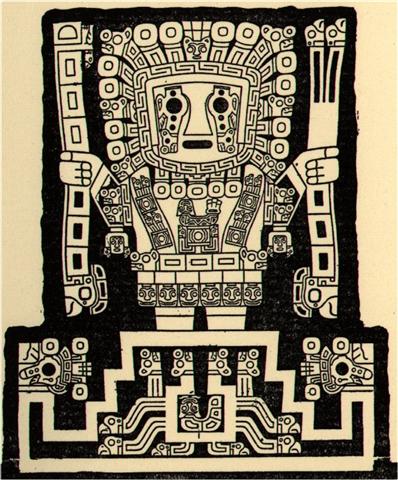

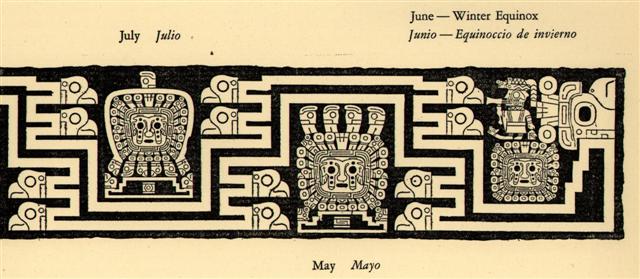
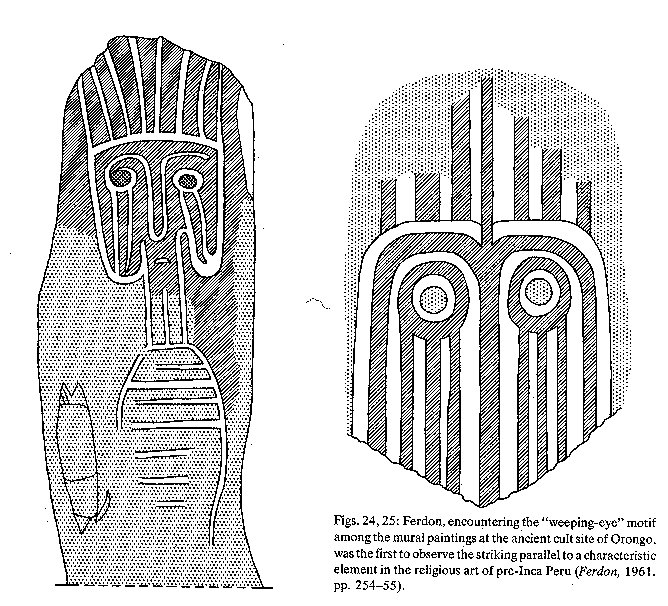
|















